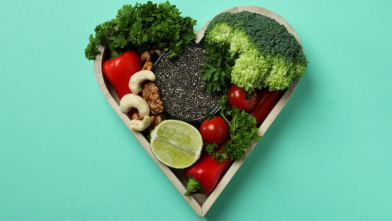Making healthy food choices is a good strategy for managing diabetes. Start by following the Diabetes Plate and learning which foods will help you reach your blood glucose (blood sugar) targets and nourish your body. Once you discover the foods you like that support your health goals, be sure to keep your kitchen stocked with them to make sticking to a balanced eating plan much easier. There are lots of options available to you, but here are 10 foods to get you started.
1. Leafy greens (such as spinach, kale, and collard greens)
Leafy greens are packed with vitamins, minerals, and antioxidants. They’re also low in carbohydrates, making them a great choice for managing blood glucose. For example, one cup of raw spinach contains about 1 gram of carbohydrate, while one cup of kale provides approximately 5 grams of carbohydrates. Include them in salads, wraps, or smoothies for a nutrient boost!
2. Berries (such as strawberries, blueberries, and raspberries)
Berries are rich in antioxidants and fiber, which can help support overall health. While they’re lower in natural sugars compared to other fruits, portions matter. For example, 1/2 cup of blueberries contains about 11 grams of carbohydrates. Berries can be a flavorful addition to yogurt, oatmeal, or eaten as a snack.
3. Legumes (such as lentils, beans, and chickpeas)
Legumes are high in fiber and protein, which can help keep you feeling full and support blood glucose management. Legumes are considered a carbohydrate food, which you will need to take into account when calculating your carbs for a meal. For instance, 1/2 cup of cooked lentils contains about 20 grams of carbohydrates. Add them to soups, salads, or stews for a hearty, satisfying meal.
4. Nuts and seeds (such as almonds, walnuts, chia seeds, and flaxseeds)
Nuts and seeds provide healthy fats, fiber, and protein, making them a nutrient-dense snack option. Be mindful of portion sizes, as they are calorie-dense. One ounce of almonds (about 23 nuts) contains about 6 grams of carbohydrates. Chia seeds are also a great source of fiber, with one tablespoon containing approximately 5 grams of carbohydrates.
5. Whole grains (such as quinoa, brown rice, oats, and whole wheat bread)
Whole grains are high in fiber and may support blood glucose management. To see if a food contains whole grains, check the ingredient list for terms like “100% whole grain” or “whole” before the grain name. A quality carbohydrate, 1/2 cup of cooked quinoa contains about 20 grams. Use whole grains for breakfast, side dishes, or as a base for grain bowls.
6. Greek yogurt
Plain low-fat Greek yogurt is an excellent source of protein and probiotics, which can support digestion and gut health. Compared to regular yogurt, Greek yogurt is higher in protein and lower in carbohydrates. For instance, one cup of Greek yogurt contains about 6 grams of carbohydrates, making it a better option for managing blood glucose. Top it with fresh fruit or a sprinkle of nuts for added flavor.
7. Avocados
Avocados are rich in healthy fats and fiber, which may help with cholesterol and blood glucose management. Heart health is especially important for people with diabetes, as they are at an increased risk for cardiovascular issues. One-half of an avocado contains about 2 grams of carbohydrates. Add avocado to salads, smoothies, or spread it on whole grain toast for a filling snack.
8. Lean protein (such as chicken, fish, and tofu)
Lean protein can help you feel full and may assist in keeping blood glucose levels steady. Keep options like skinless chicken, fish, or tofu in your fridge or freezer for quick meal preparation. For example, 3 ounces of cooked chicken breast contains no grams of carbohydrate, making it an excellent choice to pair with other nutrient-dense foods.
Sweet potatoes are a fiber-rich source of vitamin A and can be part of a balanced meal when eaten according to the Diabetes Plate (in the carbohydrate section). For example, 1/2 cup of mashed sweet potato contains about 20 grams of carbohydrate. Use them in soups, casseroles, or roasted as a side dish.
10. Olive oil
Olive oil is a heart-healthy fat that may help reduce inflammation and support blood glucose management. Use it for cooking, drizzling over salads, or as a base for dips like hummus. While olive oil doesn’t contain carbohydrates, be mindful of portion sizes to manage calories.
The Takeaway
Stocking up on these diabetes-friendly foods can help you prepare meals and snacks that align with your health goals. Aim to fill your kitchen with these nutrient-dense staples to simplify meal planning and support your wellbeing! For personalized recommendations that consider your other health concerns (like kidney disease), talk to your health care provider or registered dietician who will help you choose the foods that are best for you.
Be sure to check out all the recipes on Diabetes Food Hub and create an account so you can save recipes to try later. You can even create and print a grocery list to include these items to stock your kitchen.








